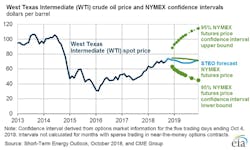EIA lifts US crude oil production forecast for 2019
In its October Short-Term Energy Outlook, the US Energy Information Administration forecast that US crude oil production will average 11.8 million b/d in 2019, which is 300,000 b/d higher than the forecast in its September STEO.
The higher production forecast reflects higher-than-expected increases to Texas and North Dakota production in July, revising upwards the baseline of the forecast, and a response to higher forecast prices.
Current global market
Both Brent and West Texas Intermediate crude oil prices reached 4-year highs on Oct. 3. Crude oil prices rose in anticipation of potentially steep declines in Iranian crude oil production and exports because of the reinstitution of US sanctions on Nov. 4.
Various trade press outfits reported that major oil importing countries including Japan, South Korea, China, and India, are planning or are considering sharp reductions in crude oil imports from Iran. As a result, the amount of Iranian crude oil supply available in the global market may be much lower than market participants initially expected in May, when the US announced it would exit from the Joint Comprehensive Plan of Action. EIA estimates that Iranian crude oil production fell by more than 400,000 b/d since May to an average of 3.4 million b/d in September.
In June, members of the Organization of Petroleum Exporting Countries, along with Russia, agreed to increase oil production levels to the original crude oil production target set in November 2016. In this year’s third quarter, OPEC members (other than Iran and Venezuela) increased crude oil production by more than the amount that crude oil production in Iran and Venezuela declined.
However, recent price increases indicate that oil market participants have concerns about the ability of Saudi Arabia, other OPEC members, and Russia to continue to offset expected further production declines in Iran and in Venezuela.
Increases in OPEC crude oil production to offset declines in Iran and Venezuela have resulted in declining OPEC spare crude oil production capacity. STEO estimates that OPEC spare capacity fell below 1.4 million b/d in September—the lowest level since December 2016 when global oil inventory levels were much higher.
IEA’s forecasts
With increased uncertainty about the amount that Iranian crude oil production could decline, and how much of the decline can be offset by other supplier, the STEO now forecasts the Brent crude oil spot price will average $81/bbl in this year’s fourth quarter, up from a forecast of $76/bbl in the September STEO.
Despite continuing production declines in Iran and Venezuela, EIA forecasts global oil supply and demand to be nearly balanced in 2019 contributing to downward oil price pressures.
By second-half 2019, when transportation constraints in the Permian region are expected to be alleviated, US crude oil production, and potentially crude oil exports, are expected to increase, which could help keep prices in the mid-$70/bbl range.
Macroeconomic risks, oil demand
Global oil demand growth for 2019 is forecast to be 1.5 million b/d in the current STEO compared with 1.8 million b/d in the April STEO.
EIA said some developed and emerging market economies may be starting to experience slower economic growth, which could result in lower-than-forecast oil demand, especially if crude oil prices continue to rise.
Using a 3-month moving average to smooth out short-term fluctuations, data from the CPB Netherlands Bureau for Economic Policy Analysis show that industrial production growth in advanced economies has begun to decelerate in January. Industrial production growth in emerging economies also has recently experienced a slight deceleration.
Among advanced economy regions tracked by CPB, the US is the only region with accelerating industrial production growth, while Japan, the Euro area, and other advanced economies are all decelerating. Industrial production growth in the Euro area, in particular, showed a year-over-year decline in July—the first decline since the beginning of 2017—as industrial production in Germany and Italy showed slowdowns.
Further, growth in gross domestic product in 2019 for countries both within and outside the Organization for Economic Cooperation and Development has been revised downward in recent months. The April STEO forecast OECD GDP growth of 2.2% for 2019; however, the current STEO forecast OECD GDP to be 2% next year. Similarly, non-OECD GDP growth was revised down from 4.3% to 3.8%.
US natural gas
EIA forecasts that dry gas production will average 82.7 bcfd in 2018, which is 1.8 bcfd higher than the forecast in the September STEO. The higher production reflects higher than expected increases to Texas production in July, increasing the baseline of the forecast.
EIA expects gas production will continue to rise in 2019 to an average of 87.7 bcfd, about 3.1 bcfd higher than the forecast in the September STEO. The 2019 upward revision is the result of increased expected production in the Haynesville region in response to higher forecast prices, upward revisions to the Permian region in response to higher prices and expected new pipeline capacity to come online in the second-quarter 2019.
In 2018, the discount of the October gas futures contract to the January contract was at its lowest in the past five years. This is because that high use of natural gas for electric power generation and LNG exports through the summer months did not allow for sufficiently high injections to compensate for the low inventory level on Apr. 1, the traditional start of the injection season.
Working gas in underground storage has remained below the 5-year (2013–17) average for most of 2018. Inventories on Sept. 28 totaled 2,866 bcf, which is 17% less than the 5-year average and 18% less than last year at this time.


